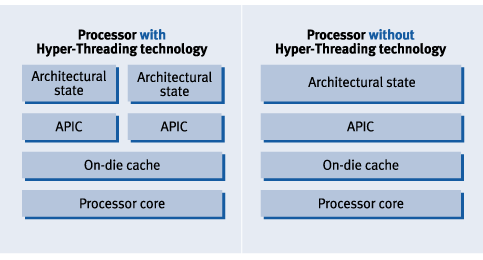Hyper-Threading Technology
PRESENTED BY
Alireza Afzal aghaei
B.Sc Computer science
Damghan university
Hyper-Threading Technology
- Hyper-Threading Technology first invented by Intel Corp.
- Hyper-Threading technology is a form of simultaneous multithreading technology (SMT), where multiple threads of software applications can be run simultaneously on one processor.
Hyper-Threading Technology
- Hyper-Threading Technology brings the simultaneous multi-threading approach to the Intel architecture.
- Hyper-Threading Technology makes a single physical processor appear as two or more logical processor.
Hyper-Threading Technology
- Hyper-Threading Technology provides thread-level-parallelism on each processor resulting in increased utilization of processor and execution resources.
- Each logical processor maintain one copy of the architecture state
Hyper-Threading Technology
- With processor and application parallelism becoming more prevalent, today’s server platforms are increasingly turning to threading as a way of increasing overall system performance.
Hyper-Threading Technology

Hyper-Threading Technology
- A multiprocessor system with Hyper-Threading technology duplicates the architectural state on each physical processor, providing two “logical” processors per physical processor.
- In Figure 1, the left-hand configuration represents a traditional multiprocessor system with two discrete physical processors.
Hyper-Threading Technology
- Each processor has its own set of processor execution resources and its own single architectural state.
- The right-hand configuration in Figure 1 represents an Intel® Xeon™ processor familybased multiprocessor system where each processor features Hyper-Threading technology.
Threading Algorithms
- Time-slicing:
A processor switches between threads in fixed time intervals.
High expenses, especially if one of the processes is in the wait state.
Threading Algorithms
-
Switch-on-event:
Task switching in case of long pauses.
Waiting for data coming from a relatively slow source, CPU resources are given to other processes
Threading Algorithms
- Multiprocessing:
Distribute the load over many processors.
Adds extra cost .
Threading Algorithms
- Simultaneous multi-threading:
Multiple threads execute on a single processor without switching.
Basis of Intel’s Hyper-Threading technology.
Resource Utilization

Traditional Multiprocessing
Here you see a multiprocessing system with two physical processors.
One processor is executing the yellow thread, and another processor is executing the dark Green thread.
The peak execution bandwidth here is 6 instructions every cycle, 3 on each processor. The system may operate at less than peak bandwidth, as indicated by the abundance of idle(white) execution units.
Hyper-Threading Technology
Here you see a multiprocessing system with two physical processors featuring Hyper-Threading technology.
One processor is simultaneously executing the yellow and dark Green threads, while another processor executes the two patterned threads.
On such a system,you can see that the system may execute at closer to peak bandwidth.
Hyper-Threading Technology
Figure 2. On a traditional multi-processor system, the idle (white) execution units indicate execution resource utilization is not optimum, while Hyper-
Threading technology not only allows multiple threads to execute simultaneously, but also reduces the number of idle execution units.
Business Benefits of H-T
- Higher transaction rates for e-Businesses.
- Improved reaction and response times for end-users and customers.
- Increased number of users that a server system can support.
- Handle increased server workloads.
- Compatibility with existing server applications and operating systems.
Benefits of H-T

Advantages
- Extra architecture only adds about 5% to the total die area.
- No performance loss if only one thread is active. Increased performance with multiple threads
- Hyper-Threading Technology is designed to increase the ability to use a processor efficiently
- Increase thread-level parallelism
Disadvantages
- To take advantage of hyper-threading performance, serial execution can not be used.
- Threads are non-deterministic and involve extra design
- Threads have increased overhead
- Shared resource conflicts
Conclusion
- Intel’s Hyper-Threading Technology brings the concept of simultaneous multi-threading to the Intel Architecture
- Hyper-Threading Technology shows performance gains of up to 30% on common server application benchmarks for this technology.
Resources
- https://www.slideshare.net/SHASHISHAW1/hyperthreading-technology
- https://www.slideshare.net/ankita_mistry/hyper-threading-13849335